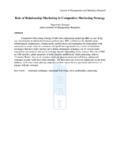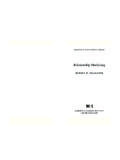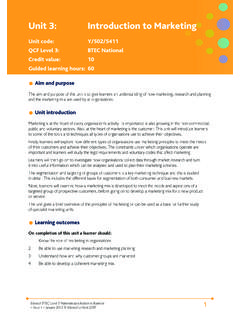Transcription of The Influence of Adaptation and Standardization of the ...
1 Available online at BAR, Curitiba, v. 8, n. 3, art. 3, pp. 266-287, July/Sept. 2011 The Influence of Adaptation and Standardization of the Marketing Mix on Performance: a Meta-Analysis Vin cius Andrade Brei * E-mail address: Universidade Federal de Santa Catarina UFSC Florian polis, SC, Brazil. L via D'Avila E-mail address: Universidade do Vale do Rio dos Sinos UNISINOS Porto Alegre, RS, Brazil. Luis Felipe Camargo E-mail address: Universidade do Vale do Rio dos Sinos UNISINOS Porto Alegre, RS, Brazil.
2 Juliana Engels E-mail address: Pontif cia Universidade Cat lica do Rio Grande do Sul PUCRS Porto Alegre, RS, Brazil. * Corresponding author: Vin cius Andrade Brei CSE/CAD/UFSC, Campus Universit rio Reitor Jo o David Ferreira Lima, Trindade, Florian polis, SC, 88040-900, Brazil. Copyright 2011 Brazilian Administration Review. All rights reserved, including rights for translation. Parts of this work may be quoted without prior knowledge on the condition that the source is identified.
3 The Influence of Adaptation and Standardization 267 BAR, Curitiba, v. 8, n. 3, art. 3, pp. 266-287, July/Sept. 2011 Abstract This article analyzes the relationship between strategies of Standardization and Adaptation of the marketing mix and performance in an international context. We carried out a meta-analysis on a sample of 23 studies published between 1992 and 2010. The sample was analyzed based on measures of the effect size (ES) or the strength of the relation (Wolf, 1986) between Standardization / Adaptation and performance.
4 The results suggest the existence of a medium strength (ES ranging from .133 to .209) for the relationship considered. The results support the existence of a positive impact of both marketing mix Adaptation and Standardization on performance. However, our results suggest that companies should slightly emphasize the marketing mix Adaptation (ES mean = .168) instead of standardizing it (ES mean = .134) when entering in a new international market. Results also indicate that, among the Adaptation choices, price (ES =.)
5 209) should be the first element of the marketing mix to be adapted, followed by promotion (ES = .155), product (ES = .154), and distribution (ES = .141). Finally, we suggest some new research paths, such as the use of quantitative methods to compare degrees of Adaptation to be applied to different segments, regions, and sectors, among other suggestions. Key words: Standardization ; Adaptation ; marketing; performance; meta-analysis. V. A. Brei, L. D'Avila, L. F. Camargo, J. Engels 268 BAR, Curitiba, v.
6 8, n. 3, art. 3, pp. 266-287, July/Sept. 2011 Introduction Considering the current globalized market, companies have seen the internationalization of their activities as a way to remain competitive. Decision-making concerning the international marketing mix has become critical, especially because of the Influence this arrangement has on performance. Thus, many authors have pointed out the need for research that relates Standardization and Adaptation to performance (Calantone, Cavusgil, Schmidt, & Shin, 2004; Dow, 2006; Florin & Ogbuehi, 2004; Julian & O'Cass, 2004; Shoham, 2002).
7 Despite such encouragement, no consensus on the relationship between the two former and the latter has yet been reached. The literature as to which is the best decision is still inconclusive, considering the type of effect (positive or negative) of Standardization and Adaptation on performance. Some authors believe that a relationship between Standardization and performance does not exist (Samiee & Roth, 1992). Others, in contrast, have found a positive link between the Adaptation of the product and its performance ( Calantone et al.)
8 , 2004; Calantone, Kim, Schmidt, & Cavusgil, 2006; Cavusgil & Zou, 1994; Lee & Griffith, 2004). Hence, the agreement about the effects of these strategies on performance represents a gap in the literature (Zou & Cavusgil, 2002), which this research aims to fulfill. Although companies strategies may Influence performance, the findings so far are not conclusive, especially those that deal with the relationships between the marketing mix and performance (Shoham, 2002).
9 Besides, contradictory and confusing results have emerged from the literature, turning marketers decision making into a difficult course of action. This discrepancy clamors for the development of more concise and accurate theories, methods, and strategic frameworks, since marketers need to understand under which circumstances each strategy turns out to be more suitable, and under which conjunctures such strategies lead to positive performance (Calantone et al.)
10 , 2004). Also, we identify the need for a statistical analysis of a large collection of analyzed data (that is, previous primary research) for the purpose of integrating the findings, and providing methodological rigor to the literature on this specific subject. These are the goals of meta-analyses, a statistical method generally centered on the relationship between one explanatory and one response variable. This relationship, the effect of X on Y, defines the analysis (DeCoster, 2004).


















